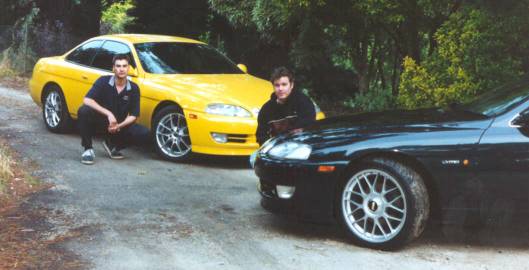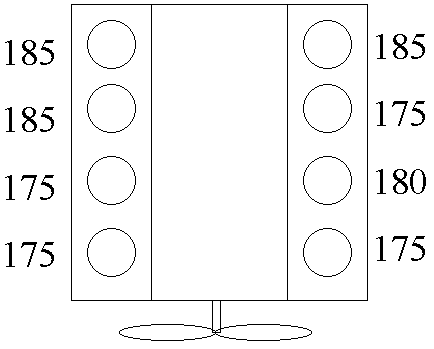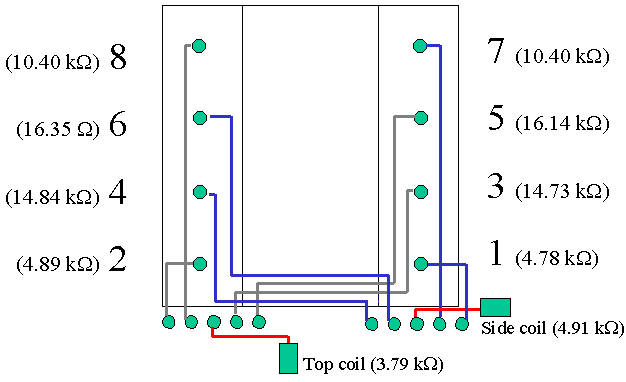
Val came over with his Lamborghini Yellow Active Soarer (same as mine!). It looked great. After discussing the Four Wheel Steer fix he had performed and looking at the complicated Japanese diagrams (thanks Steve Cheetham) it was time for some performance testing. I was quietly confident that my BFI and single sports exhaust would give me the edge, together they had reduced my car's 30-110 km/hr 2nd gear roll-on acceleration time by a second - a great improvement. What chance would he have? I drove Val's car first - I wanted to compare his 17 inch wheels for ride and handling (to my 18 inch wheels). He also had tramlining problems before getting a factory spec wheel alignment (see Steve Cheetaham's website). There wasn't much in the ride quality between the two.

I knew straight away I was in trouble, the pants dyno was telling me that his bog standard Active was more powerful than mine. Sure enough after 6 drag races later on my personal test track past the three ghost town petrol stations it was confirmed - the start was critical but his car was the gun machine. It was great to see my car driven in anger and hear the sound - it was top stuff, Val liked the exhaust tone too.
I forgot my sound recorder so I couldn't get both cars roaring past chasing each other in full stereo drive-by - doh! Next time. There are a few Soarer drivers in Adelaide on the LSOC forum now, it would be great to get them all on top of the mountain and hear 10 or so Soarers (including TT's) screaming past the mic - it will sound like a NASCAR sound track!
After the drags it was time for the downhill mountain fang. Going down the mountain in an Active Soarer is a beautiful thing, the car stays flat, it gives plenty of warning, it drifts controllably - fantastic! I set off at a fast pace, Val glued behind. I then upped the pace to drift mode, this is where all the mere mortal cars get left behind, but this was Val in an Active - he wasn't sweating it at all, it was strange to drive so hard and have a another car keep up, he probably even had a Benson and Hedges going!
The fang cheered me up but what was wrong with my car? - why was it down on power?
First thing to do was a compression test. Warm car, throttle wide open, all sparkplugs out, EFI fuse removed. The engine was a beauty - all cylinders within 10 psi, nice high compression and they pumped up real fast, four compression strokes and we were there on each one no sweat.

Figure 1 - Compression Test Results (all ok!)
Taking off the spark plug leads and two of them broke - the insides stayed connected to the plug when the lead was removed - great! This go me thinking that perhaps the leads were partly to blame. I rang around the Lexus dealers and Import Toyota guys to get advice. The vast majority recommended replacing the whole lot after 10 years as they were prone to failure. One suggested testing each lead with a multimeter and checking the resistance. All the leads should be between 5 and 15 kilo-ohms. Any in the 20-25 kilo-ohm range should be replaced. An open circuit lead (a break somewhere inside the lead) should also be replaced naturally. The leads aren't cheap though - CMI Toyota had a genuine set in stock for $390 odd dollars (standard 5mm spiral core) - all 10 leads plus the natty little black plastic holders. Andrew from MotorMate could get a set for $140 made in Australia. Magnecor could get a set for $290 odd dollars (7mm core with 5 mm cap boots). Individual leads were about $50 ex - japan which meant a 3-4 week wait. Doing an internet search revealed more info. The two I recommend reading are:
http://www.magnecor.com/magnecor1/main.htm
Magnecor - a great site - plenty to read - get stuck into it!
I forget the other site actually - I will try to find it again. Basically the guy had tested a bunch of different leads. New Toyota ones had a resistance of 20 ohms/mm, other aftermarket ones were down at say 11 ohms/mm.
Important to note that lower resistance does not mean more power.
Low electrical noise leads have a high resistance.
So armed with this info it was time to check all of my leads. I was looking for total resistance lower than 15 kohms and no open circuit leads. Two were already stuffed (broke).
The first test is the pitch black test. Remove engine covers so you can see all of the leads. Start car and turn off all the lights. It should be pitch black, no sparking, no corona's no nothing. This is to make sure the leads aren't arcing externally. No worries there - I couldn't see or here any sparking.
There are two coils on the V8, one top left, the other lower right. The caps ( represented by the two sets of 5 green dots at the font of the engine) are under the plastic engine covers. Rotors (under the caps ) rarely fail but the caps do sometimes crack - if they look ok then they will be fine.

Figure 2 - V8 lead schematic

No need to completely remove the leads to test them - just unplug the ends. Be careful with the coil leads - they are held on with a plastic lock down - inspect carefully! - They come off easily when you press the tab down. All of my caps had a fine white powder inside the boots. I cleaned them all and used a bit of CRC 2-26 electrical contact spray.
Well the results were surprising. Keep in mind the car started just fine and ran beautifully - no missing at all.
Table 1 - Plug lead tests
| lead | length (cm) | ohms x 1000 | ohm/mm |
| 1 | 20 | open | |
| 2 | 30 | open | |
| 3 | 67 | open | |
| 4 | 78 | 15.9 | 20.38 |
| 5 | 85 | 16.25 | 19.12 |
| 6 | 90 | 16.50 | 18.33 |
| 7 | 56 | 19.69 | 35.16 |
| 8 | 66 | open | |
| top coil | 24 | 3.85 | 16.04 |
| side coil | 31 | 5.40 | 17.42 |
| Bosch Super Sports inductive core (Black) | 66 | 3.48 | 5.73 |
| Bosch Hi-Performance Silicone (Blue) | 30 | 4.80 | 16.00 |
The leads from the coils to the caps were fine.
50 % of the spark plug leads were absolutley stuffed.
Of the remaining spark plug leads one was getting a bit high and the rest were borderline.
The new Bosch leads I bought (5 bucks each) to replace the broken ones were great too. Replacing the two broken leads reduce acceleration time by 0.5 seconds. The leads had to be "adjusted" to get the larger 7mm boots to fit into the 5mm caps.
The open circuit leads still fired the cylinder because the high voltages are able to jump the internal breaks.
Perhaps replacing the all the spark plug leads will get some performance back - we shall see.
Conclusion:
My leads were stuffed and I didn't even know it - there was no evidence to suggest it. I wouldn't have known at all if I didn't drive Val's car and had then started to look for things. Replacing two leads made a positive difference.
Next is to replace all the sparkplug leads and see how things improve.
(Actually looks like the valve clearances had something to do with it too - keep an eye out for Camshaft page coming up)
